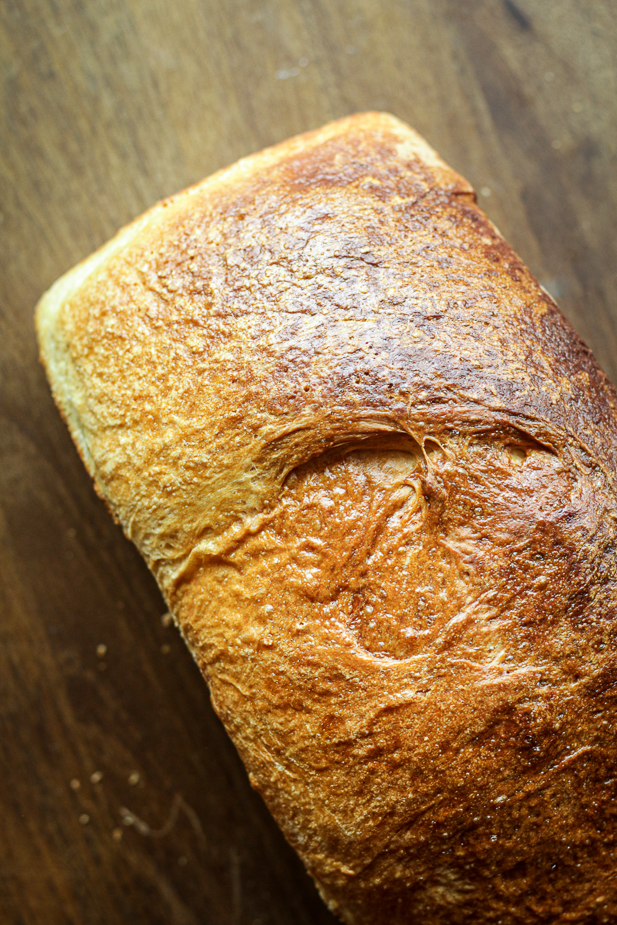

I am going to be honest with you, I was intimidated by making brioche initially. This recipe looks like it has a lot of steps and it certainly takes some planning to have time for proofing, but the actual process is pretty simple. A stand mixer does all the work, but the key is patience and letting the dough work itself out to the perfect texture. It will be shaggy at first, and as you add the butter, it looks like it won’t come together, but somehow it always goes from a shaggy, messy dough to a smooth, elastic ball as the mixer does the kneading.
Patience is the name of the game with the whole process, since it needs some long rising time. I prefer to make a batch one day, let slowly proof in the fridge overnight, then have it ready for forming and proofing for the second time the next day. The dough can also be frozen, so even if you don’t need both loaves, you can make both and freeze what you don’t need.
This bread is amazing and indulgent on it’s own or toasted, but my favorite way to use it is to make it into treat breads and pastries (more of those types of recipes to come…)
- 2¼ cups all-purpose flour
- 2¼ cups bread flour
- 3¼ teaspoons dry active yeast
- ⅓ cup granulated sugar
- 1 tablespoon kosher salt
- 5 large eggs (plus 1 egg for egg wash)
- ½ cup water
- 1 cup plus 4 tablespoons butter (2.5 sticks), softened at room temperature and cut into about 12 pieces
- Using a stand mixer fit with a dough hook, combine flours, yeast, sugar, salt, 5 eggs, and water. Mix on low speed for about 3 minutes or until ingredients come together to form a shaggy dough, scrapping down sides as needed. Mix another 3-4 minutes on low until dough stiffens a bit.
- With the mixer on low speed, add pieces of butter, one at a time, until incorporated into the dough. Once all the butter has been added, continue to mix at low speed for 10 minutes to ensure all butter is well mixed.
- Increase the speed to low-medium, and continue to mix, letting dough knead in mixer, for about 10-15 minutes until the dough is soft, shiny, and elastic. The dough should be a little sticky, but if too really wet or loose you can add a little flour, a few tablespoons at a time, until to comes together. The dough is ready when you pull a piece off gently and it stretches rather than breaking off, and when you can gather it in one piece (although it still will feel quite soft).
- Transfer to a large bowl or container and cover with plastic wrap directly over the surface of the dough. Let dough sit in fridge for 6 hours or up to overnight to slowly proof. You can let if proof faster in a warm spot in the kitchen (about 3 hours), but the flavor and texture develops more if left in the fridge overnight.
- Generously spray two 9x5 inch loaf pans with non-stick cooking spray or line with parchment.
- Divide the dough in half on a clean work space that has been lightly floured. Form each half into a large, 8-9 inch square. Fold each dough square roughly into thirds like you are folding a letter and press together gently. Place dough, seam side down, into prepared pans.
- Cover the loaves lightly with plastic wrap or with a tea towel. Place in a warm area in the kitchen and allow to rise about 2-3 hours until doubled in size.
- Preheat oven to 350 degrees F. Whisk 1 egg and mix with about a tablespoon of water, then lightly brush egg mixture over the tops of the loaves. Place loaves in oven and bake about 35-40 minutes, until tops are golden brown. Let cool and serve.
If you are using this recipe for other recipes requiring brioche dough (babka, rolls, etc), you’ll want to use the dough after the first proof in the fridge.
After the first proof in the fridge, dough can be wrapped tightly in plastic wrap or placed in an airtight container and frozen. Dough works best if used within 1-2 weeks and allowed to thaw in the fridge for 6-8 hours (or overnight) before using.
Adapted from Flour, Too.


Leave a Reply